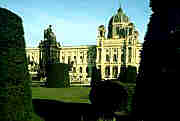 |
A City of Empire
Retains Her Glory |
 |
Part II - The "Ringstrasse" and other Imperial Monuments
The Habsburg emperors once ruled a huge empire from Vienna. The city is still dominated by the castles and places of the imperial seat.
Every year hundreds of thousands come to marvel at "The Place in the Country" - Habsburg's magnificent "imperial summer residence"
Schönbrunn Palace. |
 |
Emperor Franz Joseph ordered the demolition of the city walls 130 years ago. When most of the old city walls had to be removed in the middle of the nineteenth century, a majestic tree-lined boulevard circling the old part of the city was erected in their place. Since then, "the Ring" has become a prime showcase for most of Vienna's architectural attractions: the two imposing museums (Fine Arts and Natural History) are gazed upon by a stature of Empress Maria Theresa; Parliament with a marble statue of Pallas Athena; the most important German-language theater, the National Theatre (Burgtheater); Vienna's renowned University; and two marvelous examples of neo-Gothic architecture: City Hall (Rathaus) with its splendid park and the Votive Church (Votivkirche) with its double spires that seem to be made of fine lace; several imposing ministry buildings; and finally, the resplendent State Opera House, which reopened completely renovated in 1955 after it had been almost totally destroyed during the last war.
 |

Museums |

Parliament |

Votiv Church |
The Votiv Church was built by Maximilian, brother of Franz Josef and Emperor of Mexico, in memory of an assassination against Franz Josef in this park area. He was attacked with a knife against the throat. But the uniform had such stiff collar, that the knife didn't get through....

St.Stephan's |

Karls Church at Karlsplatz |

Giant Ferris Wheel |
Churches played a major role in catholic Austria. Surprising as it may seem, a few were built even before the Habsburgs were on the horizon - Vienna's oldest church, St. Rupert's (Rupechtskirche), is one example; another, majestic St. Stephen's Cathedral, existed before the Habsburgs, but was not transformed to its present Gothic beauty until the Habsburgs came along; for many centuries now, it has been the landmark of Vienna. Due to its location in the middle of the old city, it has become a focal point as well as a favorite meeting place. There are some who consider magnificent St. Charles Borromeo (Karlskirche), with its green cupola, one of the finest examples of baroque architecture in all of Europe.
The Riesenrad (Giant Ferris Wheel) was build for a world exposition at the ending 19th century. It is today a must to take a slow 10min ride and to have a wonderful view of Vienna center.
PAGE 2 |

















